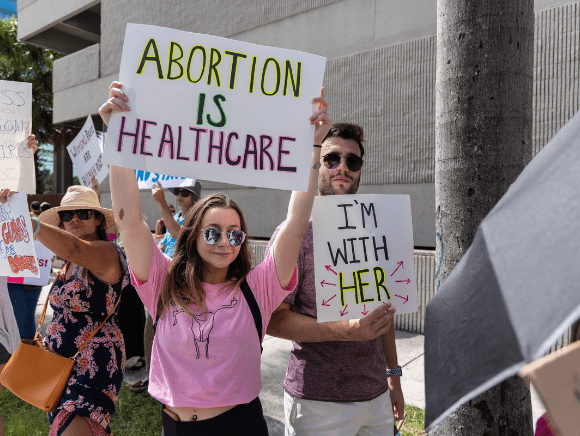
(Photo by John Parra/Getty Images for MoveOn)
The US House of Representatives passed two abortion access bills on Friday, July 15. The Ensuring Access to Abortion Act sailed through 223-205, and the Women’s Health Protection Act – an old crowd favorite amongst Democrats, it seems – advanced 219-210. But with a clear majority in the House, Democrats had little to worry about. The Senate is a bit different. It takes 60 votes to invoke cloture and break a filibuster, while Democrats have only 50. Of the 213 Republicans in the House, none signed on to the WHPA and just three supported the travel protection bill. What hope do Senate Democrats have of convincing ten of their GOP colleagues to be more supportive?
The Law Masquerading as Roe

Thanks to the quick work of the House, the Senate will for a third time consider the Women’s Health Protection Act. It failed twice before, so what’s different? As it turns out, very little beyond lamenting the loss of Roe, and Liberty Nation has examined it before. This version still federally protects abortion access up to the point of viability, which is the point at which, in the “good-faith medical judgment of the treating health care provider,” the baby can survive outside the uterus “with or without artificial support.” Viability has historically been considered to be about 24 weeks. However, under the language of this law, one could make an argument that, since infants born prematurely are more likely to fail than those carried to term even with medical intervention, a willing physician could deem a fetus not viable without artificial support much later in the pregnancy.
The Act still allows for the prescription of pregnancy-ending medications by telehealth services and forbids states from requiring any extra doctor visits or exams first. Presumably, this would allow a pregnant woman to be prescribed abortifacients without first verifying gestational age.
Parental notification requirements would be illegal, as would any other regulation with a “reasonable likelihood” of deterring some patients indirectly. The Act still includes language that grants the right of individuals and the US Attorney General to sue any state with a restriction “whether adopted before or after the date of enactment of this Act,” meaning states could presumably be sued for laws currently considered constitutional. The Women’s Health Protection Act was billed from the very beginning as a way to “codify Roe,” but it is and has always been considerably more.
The Abortion Access Law We Never Needed
No federal law is needed to guarantee the right to travel between the states. It has been guaranteed in America since before the current version of the United States existed. While the Articles of Confederation stated the right of free movement more explicitly than the Constitution does, Article IV, Section 2 has long been interpreted to guarantee the same. “The Citizens of each State shall be entitled to all Privileges and Immunities of Citizens in the several States,” reads the opening line of the section. From Crandall v. Nevada in 1868 to Saenz v. Roe in 1999, the Supreme Court has traditionally affirmed this right.

Senate Minority Leader Mitch McConnell, R-KY, right, and Senate Majority Leader Charles Schumer, D-NY (Tom Williams/CQ-Roll Call, Inc via Getty Images/)
Fugitives from the law, of course, are to be returned to the state in which they are wanted. That much is clear, thanks to the second paragraph of Article IV, Section 2: “A Person charged in any State with Treason, Felony, or other Crime, who shall flee from Justice, and be found in another State, shall on Demand of the executive Authority of the State from which he fled, be delivered up, to be removed to the State having Jurisdiction of the Crime.”
The problem with preventing a woman from traveling to a more abortion-friendly clime is that interfering in her free movement between the states is only allowed if she happens to be a fugitive. Every ban in the nation right now specifies that it’s the one who performs the procedure – not the pregnant woman – who will be charged. Even without that wording, a person can’t be charged for a crime they haven’t committed, and it isn’t a crime to do something in a place where it is legal just because it’s illegal at home.
As for the doctors in abortion-friendly states, their local laws protect them. The state of Arkansas, for example, cannot charge a doctor licensed in Illinois for performing – in Illinois – a procedure that’s legal there. So should a woman travel from Arkansas to Illinois to end her pregnancy, there is no law, nor could there constitutionally be one, which prevents her from doing so and returning home free from prosecution.
But that isn’t the only issue with the Ensuring Access to Abortion Act of 2022 – and the second is right there in the name. The bill could have been a protection of the free movement of anyone not on the lam between the states – just in case the Supreme Court ever does decide differently. Instead, it applies only to those looking to end their pregnancies, leaving everyone else to the mercy of whatever restrictive state law might inspire a future SCOTUS to decide interstate travel isn’t a right after all.
An Exercise in Futility
The Women’s Health Protection Act of 2021 failed in the Senate not just once, but twice. Now congressional Democrats are trying again. Third time’s the charm? Probably not. The Senate shot it down twice, and there’s no reason to assume the same set of lawmakers will do differently now. Absolutely zero Republicans supported this in the House.
The Ensuring Access to Abortion Act seems about as likely to pass. Three Republicans – Adam Kinzinger (R-IL), Fred Upton (R-MI), and Brian Fitzpatrick (R-PA) – voted in favor of this bill, but it will take ten GOP senators to pass it. The only other chance would be some combination of votes totaling 51 to do away with the filibuster. While both abortion access bills cleared the House easily, neither is likely to become law.
Remember to check out the web’s best conservative news aggregator
Whatfinger.com — the #1 Alternative to the Drudge


